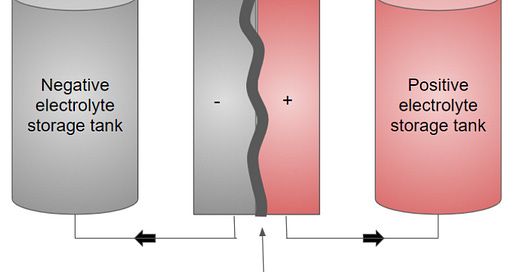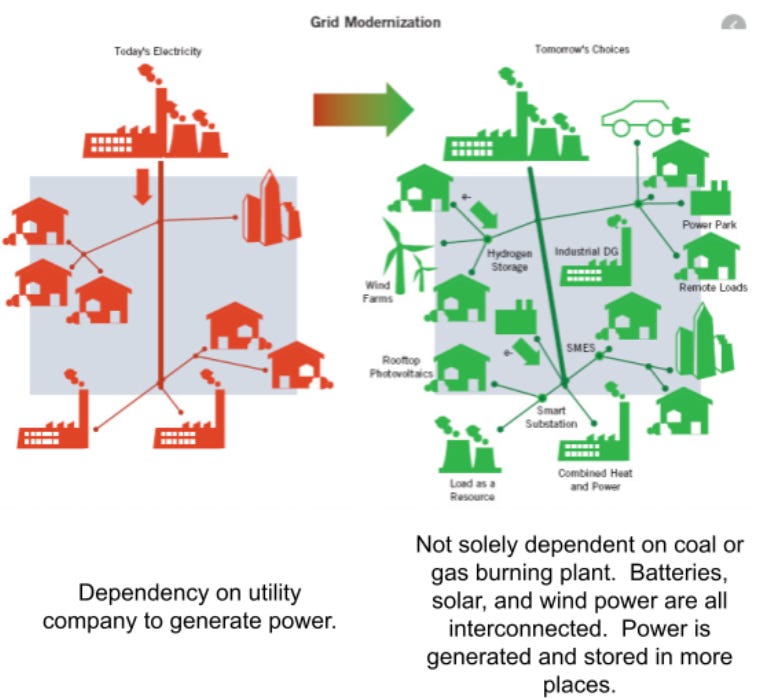The energy grid is complex, and it seems the consumer is beholden to the rates that utility companies charge. The news from California/PG&E (2018) and more recently the thousands of Texans that lost power and water supply to the recent winter storm (Feb 2021) highlight the aging power transmission infrastructure. The traditional energy grid requires an expedited transformation toward new and efficient advancements in transmission and renewable energy generation.
The world is increasingly capturing energy from the wind, sun, and water yet we are still paying utility companies for electricity that is produced from burning coal and natural gas plants. Yes, most understand it does not change overnight, but take a step back and think about batteries and how they could be employed to store energy. The current system of distributing power can be easily disrupted by natural disasters (referenced above), because the supply is dependent on one source.
As grid energy storage evolves, more batteries and solar panels will be installed in homes. Electric vehicles will also continue to gain more adoptance, and once consumers realize the potential of transferring the energy from their car battery to their home (and vice versa), reliance on traditional utility companies will decline.
Part of the new modernization equation is the vanadium flow battery. The VFB is a type of rechargeable battery that uses vanadium ions in different oxidation states to store energy. Vanadium, a transition metal, exists in four common oxidation states (+2, +3, +4, +5), therefore allowing it to be used at both the anode and the cathode.
What is the Vanadium Flow Battery?
It is a battery that operates under the same principles as a lithium ion battery, except that the anode and cathode are liquids. The battery is made by dissolving vanadium pentoxide (V2O5) in sulfuric acid (H2SO4) to make the electrolyte. Electrolyte tanks can be filled with pumps to enable flow via the schematic below.
When the battery is charged the anode gains an electron.
When the battery is discharged the anode loses an electron.
The overall reaction creates safe byproducts of water and hydrogen ions.
An ion exchange membrane (also called proton exchange membrane) separates the anode and cathode, but is permeable enough to allow ions to travel across it. When the battery is charged VO2+ is converted to VO2+ in the positive ½ cell. At the same time the anode gains an electron converting V3+ to V2+. During discharge this reaction is reversed and generates an operating cell voltage of 1.41V.
Why VFBs?
Some industry executives will ask why not consider Li-ion batteries? The thinking is sound, but VFBs will be longer lasting and more sustainable for a future electrical grid.
On first glance, Li-ion batteries do seem to make a good case for storage batteries. Higher voltage, specific energy, and density are superior, but they have size limitations.
The long cycle life of VFBs is clearly a driver for this technology as well as some other properties listed below.
The major negative for standard Li-ion batteries used in grid storage is due to self-discharge. Your phone and laptop batteries go through self discharge all the time. Think about what happens when you fully charge your battery. Even if you do not use your device, the battery life will slowly decay.
Vanadium flow batteries are much more stable, and power output can simply be governed by the size of electrolyte tanks that are used to make the battery.
Conclusions
In 1882 the electrical grid was born. Commercial electricity distribution has enabled world growth and development and allowed us to live easier lives. As the energy grid evolves, vanadium flow batteries are practical solutions for a sustainable future.
The largest operating VFB, Minami Hayakita Substation, has an energy output of 60 MWh and power of 15MW, and can sustain that output for four hours. VFBs are also being built in Germany, China, and the USA. In fact, China is finalizing construction on a 800 MWh VFB in Dalian, which would help alleviate about 8% of the city’s electrical load.
Grid storage is an emerging industry as a way to harness and store power for later use. Batteries and renewable energies will continue to cause massive disruption across many industries for decades. It may be painful for legacy utility companies, but the shift to sustainable power generation, storage, and transmission will be a net benefit to consumers and the planet.
References:













